Chipping
If
you can always stay in the fairway and hit every green, all you
need is the Simplified Base Swing and
your putter. Unfortunately, that never happens to us amateurs. Therefore we need a variety of shots to
deal with the aftermath of our misses. Instead of using different techniques for different shots, letís
make it simple by reusing what we already know.
your putter. Unfortunately, that never happens to us amateurs. Therefore we need a variety of shots to
deal with the aftermath of our misses. Instead of using different techniques for different shots, letís
make it simple by reusing what we already know.


Chipping,
Pitching,
Flop, Bunker, and
others
others
The
simplest way to chip is to forget that you are chipping.
Just pretend you are putting. Here is how to
do it:
You will be surprised by how easy it is to make solid contact this way. Remember the speed practice
youíve done for your putting? Itís completely applicable here. If you use the length of your back stroke to
control the distance of your putts, do the same here. All the other good habits that youíve developed for
your putting carry over as well. E.g. keep your head steady, donít follow the ball with your eyes.
Practice with at least two clubs. One that rolls the ball the same distance as it flies. The second one (a
less lofted club) that rolls twice the distance. Whenever possible, minimize the air time and maximize
the ground time. E.g. if you are 12 yards from the hole and the fringe is 3 yards away from you, use the
club that will let you land on a spot 4 yards from you (1 yard into the green) and roll the remaining 8 yards
instead of flying 6 yards and roll another 6. As you get proficient with the two clubs, you can add
additional clubs into your repertoire. E.g. a club that will roll the ball 3 times longer than it flies, or a
hybrid to get out of longer rough.
There is a reason we donít show any picture or video here. Putting is very individualized. There is no
Ďrightí or Ďbestí way to putt. Whatever mechanics that gets the ball in the hole is the best one for you. In
general, a good putting stroke gives you good control of speed and direction. If it works well on putting, it
will work well on chipping for you too.
do it:
- Use
your putting grip and grip the chipping club the same length
as you would gripping your
putter
- Take
a narrow and slightly open stance with the majority of your
weight on your front foot (your
shoulders are still parallel to the target line)
- Place
the ball back in your stance
- Aim
for your landing spot
- Just
putt away!
You will be surprised by how easy it is to make solid contact this way. Remember the speed practice
youíve done for your putting? Itís completely applicable here. If you use the length of your back stroke to
control the distance of your putts, do the same here. All the other good habits that youíve developed for
your putting carry over as well. E.g. keep your head steady, donít follow the ball with your eyes.
Practice with at least two clubs. One that rolls the ball the same distance as it flies. The second one (a
less lofted club) that rolls twice the distance. Whenever possible, minimize the air time and maximize
the ground time. E.g. if you are 12 yards from the hole and the fringe is 3 yards away from you, use the
club that will let you land on a spot 4 yards from you (1 yard into the green) and roll the remaining 8 yards
instead of flying 6 yards and roll another 6. As you get proficient with the two clubs, you can add
additional clubs into your repertoire. E.g. a club that will roll the ball 3 times longer than it flies, or a
hybrid to get out of longer rough.
There is a reason we donít show any picture or video here. Putting is very individualized. There is no
Ďrightí or Ďbestí way to putt. Whatever mechanics that gets the ball in the hole is the best one for you. In
general, a good putting stroke gives you good control of speed and direction. If it works well on putting, it
will work well on chipping for you too.
Pitching
When
you get within 60 yards or so and your most lofted club will send
the ball too far, you need to hit
half shots. Pelz has an elaborate system that involves 4 wedges, 3 different backswing length, and 12
combinations of distance. Itís excellent if you have the time to practice. Unfortunately, most of us canít
afford the time. So letís simplify.
Essentially, we need shots that can get us to a pin 30, 40, 50, and 60 yards away. If we are closer than
30, chipping is probably the best option. If we are further than 60, itís likely that a normal swing with the
right wedge will get you there.
For 30 yards, the safest shot is a pitch and run. The ball flies 2/3 of the way and roll about another 1/3.
(We will discuss the flop shot that flies all the way later in case you have a hazard right before the
green.) For most people, the following works well:
half shots. Pelz has an elaborate system that involves 4 wedges, 3 different backswing length, and 12
combinations of distance. Itís excellent if you have the time to practice. Unfortunately, most of us canít
afford the time. So letís simplify.
Essentially, we need shots that can get us to a pin 30, 40, 50, and 60 yards away. If we are closer than
30, chipping is probably the best option. If we are further than 60, itís likely that a normal swing with the
right wedge will get you there.
For 30 yards, the safest shot is a pitch and run. The ball flies 2/3 of the way and roll about another 1/3.
(We will discuss the flop shot that flies all the way later in case you have a hazard right before the
green.) For most people, the following works well:
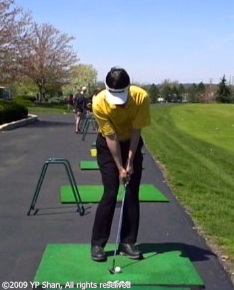
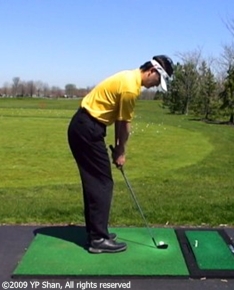
- Take
the lob wedge
- Grip
down
- Use
a slightly open and narrower stance (some even like to have
their feet together)
- Keep
the majority of your weight on the inside edge of your front
foot (since you are not hitting
with full power, any weight shift is unnecessary and would only make solid contact harder)
- Use
the Simplified Base Swing (i.e. arms connected, head
steady, rotate the left shoulder
toward the ball and the other good stuff)
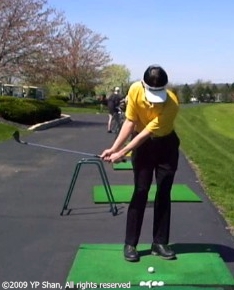
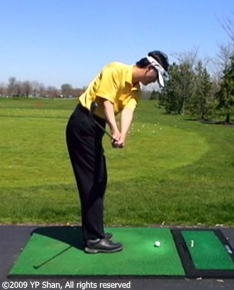
- Take
your back swing to where your left arm is around the 7:30
position (You need to calibrate
the length of your backswing to your own spin, trajectory, and the firmness of the course.)
- Swing
forward using your core and donít actively flip your hands
(discussed in the Base Swing).
In fact, you should feel like you are holding your wrist bend while turning your body through the
ball.
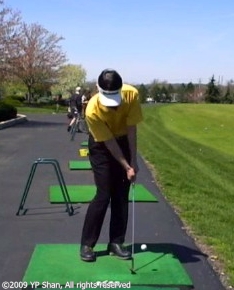
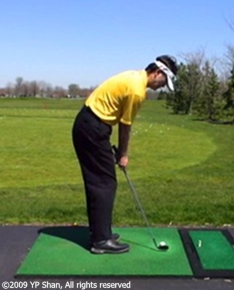
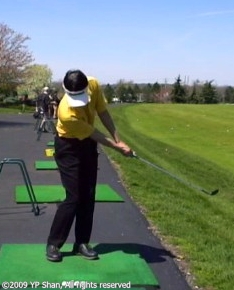
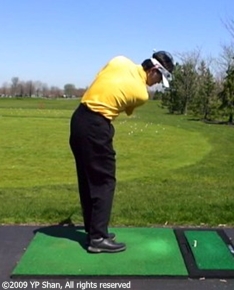
Click
on the images below to see the shot in slow motion.
For
the 40-yard pitch and run, do exactly the same as above but use a
sand wedge instead of the lob
wedge.
For 50 yards, you have more room to fly and apply more spin so the ball will stop on the green. Use the
lob wedge. Do the same as the 30-yard swing above with the following adjustments:
wedge.
For 50 yards, you have more room to fly and apply more spin so the ball will stop on the green. Use the
lob wedge. Do the same as the 30-yard swing above with the following adjustments:
- Donít
grip down
- Less
narrower stance
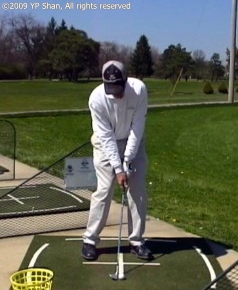

- Take
your back swing to where your left arm is around the 9:00
position
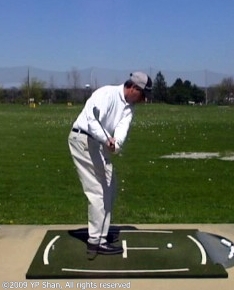
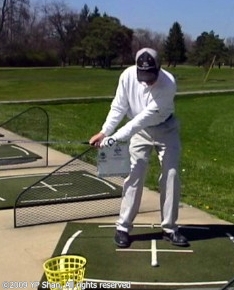
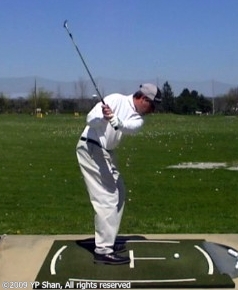
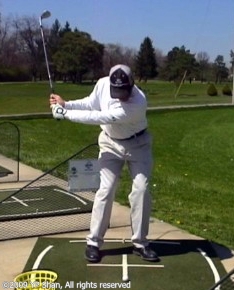
Don't
forget to keep your head steady and finish in balance.
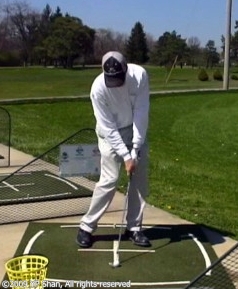
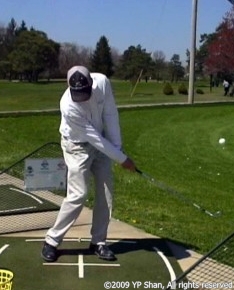
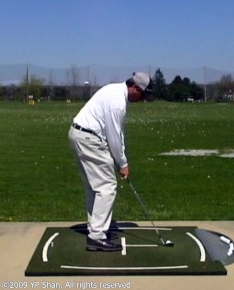
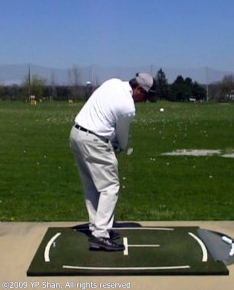
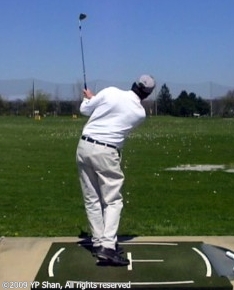
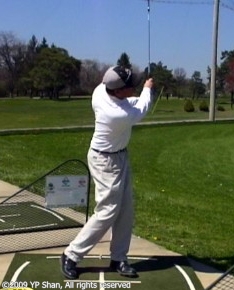
If
you hit it too far, open the club face and stance a bit so the
ball goes higher, spins more, and lands
shorter. If you are not far enough, do the opposite.
Click on the images below to see slow motion video of the 50-yard pitch.
shorter. If you are not far enough, do the opposite.
Click on the images below to see slow motion video of the 50-yard pitch.
Flop
Most
people consider the flop shot a low percentage shot and we donít
encounter situations that need it
that often. So why bother learning and practicing it? Well, first itís not that hard to pull off if you already
can do the base swing. Secondly, and more importantly, the exact same swing can be used to hit
bunker shots (which we will encounter on a regular basis) and to get the ball out of tall thick rough. Here
is how to do it.
Follow everything in your 50-yard pitch shot with the adjustments below:
that often. So why bother learning and practicing it? Well, first itís not that hard to pull off if you already
can do the base swing. Secondly, and more importantly, the exact same swing can be used to hit
bunker shots (which we will encounter on a regular basis) and to get the ball out of tall thick rough. Here
is how to do it.
Follow everything in your 50-yard pitch shot with the adjustments below:
- Open
the stance and the club face more (use 20-30 degrees as a
starting point)
- Align
yourself so the club face points to the target
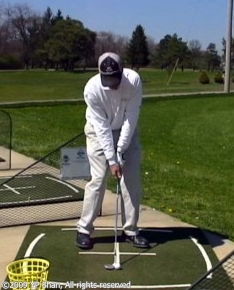
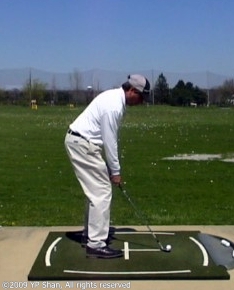
The
following are part of the Simplified Base Swing but they are worth
repeating:
- Rotate
your left shoulder toward the ball during the backswing
-
Since
you have an open stance, the club will naturally go back
shallower and come back
down from the outside in, which is what you want.
- Keep
your right arm connected with your core and right elbow in
front of you
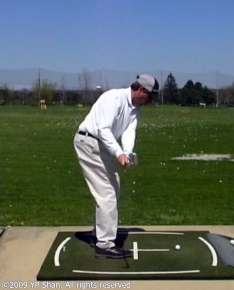
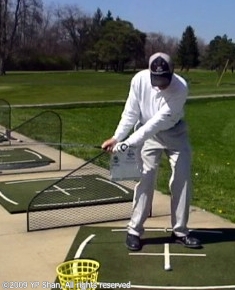
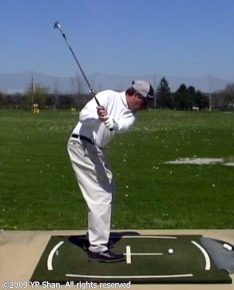
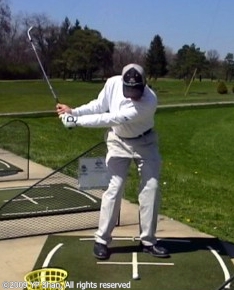
- Donít
flip your hands so the clubface remains open instead of
shut. If you do this correctly you
should feel the bounce at the bottom of the clubhead hitting and gliding through the ground.
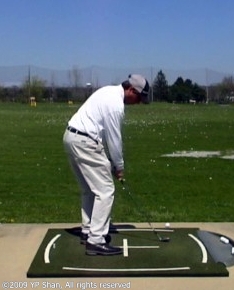
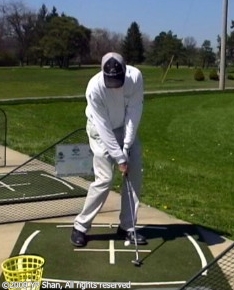

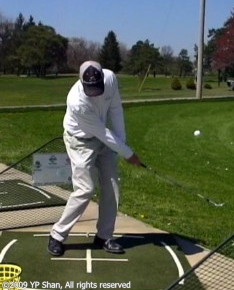
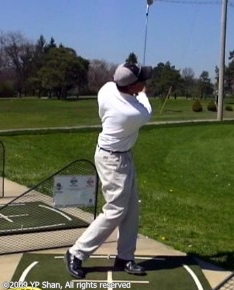
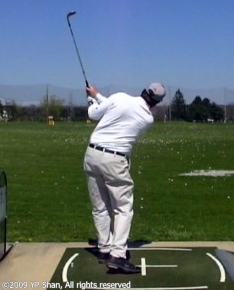
You
can experiment with the openness of the clubface at address.
The more open it is the higher the
trajectory and the shorter the distance.
Click on the images below to see slow-motion video of the flop shot.
trajectory and the shorter the distance.
Click on the images below to see slow-motion video of the flop shot.
Green
Side Bunker
Mechanically
this
is identical to the flop shot. Here are the adjustments to
deal with the sand:
- Dig
your feet into the sand
- Move
the ball forward in your stance by about 2-3 inches
-
The
club will enter the sand at the middle of your stance.
Since the ball is moved forward,
it will come out with a cushion of sand underneath it (roughly the size of a dollar bill).
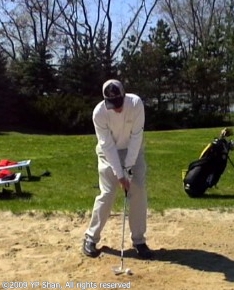
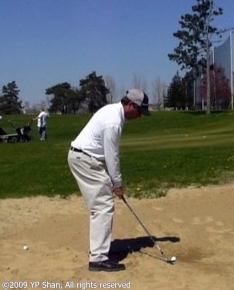
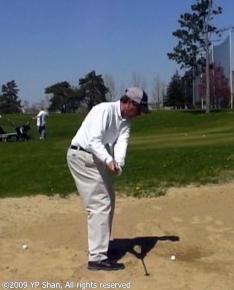
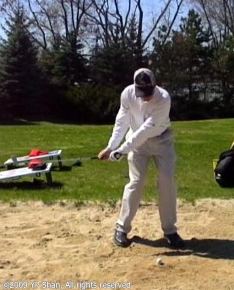
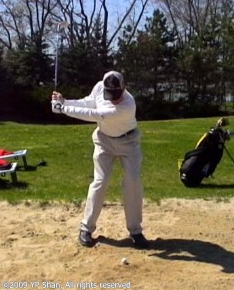
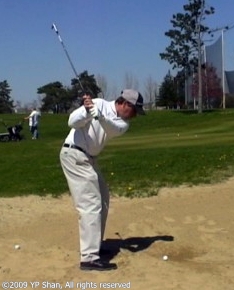
- Aim
slight right of your stance line. Since
the clubface never contacts the ball, the ball flies where
the sand goes. Even with a wide open clubface, the ball wonít go as far right as a flop shot. It
will only go slightly right of your swing path.
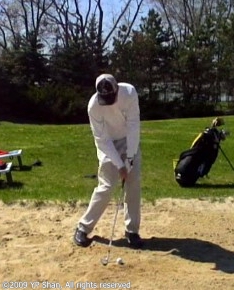
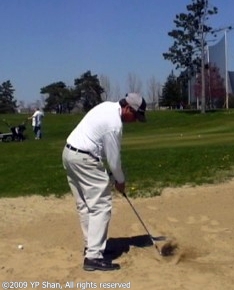
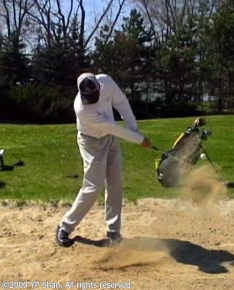
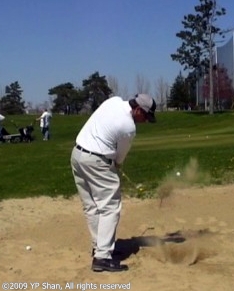

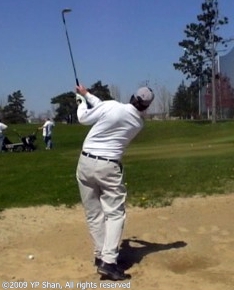
clubs. Most of the clubs today have plenty of bounce even up to the 9-Iron (like 5 degrees). When you
open the clubface, the effective bounce increases even more. Feel free to use your other wedges and
short irons for longer distance.
If you donít have regularly access to a practice bunker, you can still hone your bunker shot by hitting a lot
of flop shots. The beauty of our simplified system is that they are mechanically the same. All you need
is occasionally go to a bunker to calibrate the distance and direction.
Click on the images below to see slow-motion video of the bunker shot.
Thick
Rough
When
your ball is sitting way down in a thick rough and you canít see
the side of the ball, there is not
much you can do. Use the bunker shot above to extract the ball. Expect the ball to roll a lot since the
grass between the club face and the ball will take out most of the back spin.
If itís sitting up and you can see the back of the ball very well, hit it like it is teed up with the Simplified
Base Swing. If there will be a little bit of grass between the ball and the club face, watch out for a flyer
that will go longer than your normal distance.
much you can do. Use the bunker shot above to extract the ball. Expect the ball to roll a lot since the
grass between the club face and the ball will take out most of the back spin.
If itís sitting up and you can see the back of the ball very well, hit it like it is teed up with the Simplified
Base Swing. If there will be a little bit of grass between the ball and the club face, watch out for a flyer
that will go longer than your normal distance.
Fairway
Bunker
Many
people believe that the fairway bunker shot is the toughest shot
in golf. In reality, if you make the
right adjustments, itís not that difficult. Here is how:
Golf is very psychological. If you believe the fairway bunker shot is hard, it will become hard for you. If
you donít believe or, better yet, donít know it, there is not much to it. Youíve been making contact with the
ball first and then the turf on all the regular iron shots. If you can just account for the lack of traction due
to the sand (by digging in and restricting your leg movements), you will be just fine.
right adjustments, itís not that difficult. Here is how:
- Take
one or two extra clubs
- Grip
down some
- Dig
your feet in
- Move
the ball back in your stance
- Keep
your weight on the left foot
- Make
a smooth three quarter swing
-
This
helps quiet down your legs to ensure ball first contact.
The extra club will make up
for the lost distance
Golf is very psychological. If you believe the fairway bunker shot is hard, it will become hard for you. If
you donít believe or, better yet, donít know it, there is not much to it. Youíve been making contact with the
ball first and then the turf on all the regular iron shots. If you can just account for the lack of traction due
to the sand (by digging in and restricting your leg movements), you will be just fine.
How
have we simplified?
We
simplified many things for you by basing all the shots on the
Simplified Based Swing and your
putting stroke (both you need to practice and master anyway). The different shots also build on top of
each other. If there is a path to avoid learning something new, we took it. Remember UST 2: The fewer
the concerns of a swing, the simpler it gets.
We also worked hard to minimize the required adjustments for each shot (UST 2 again). We further
simplify by pushing most of the adjustments to setup which happens before the actual swing (UST 3).
E.g. Using different clubs to control the length of green side bunker shots moves cognitive load (i.e.
distraction) and the corresponding adjustment to prior the swing.
All of these make the shots simpler to learn and execute. Since practicing one shot aids the practice of
another, we reduced the practice time as well.
putting stroke (both you need to practice and master anyway). The different shots also build on top of
each other. If there is a path to avoid learning something new, we took it. Remember UST 2: The fewer
the concerns of a swing, the simpler it gets.
We also worked hard to minimize the required adjustments for each shot (UST 2 again). We further
simplify by pushing most of the adjustments to setup which happens before the actual swing (UST 3).
E.g. Using different clubs to control the length of green side bunker shots moves cognitive load (i.e.
distraction) and the corresponding adjustment to prior the swing.
All of these make the shots simpler to learn and execute. Since practicing one shot aids the practice of
another, we reduced the practice time as well.
Yet
a bunch of other shots
There
are certainly other shots not covered above that you will
eventually encounter. E.g. hardpan,
restricted backswing, ball in divot, ball half emerged in water, etc. The good news is that you wonít see
them very often (we hope). There is also likely an easy (but chicken) way out that will cost an extra
stroke but not the big numbers. E.g. chip or even putt out of a hardpan to the nearest fairway.
If you feel adventurous, you can also adapt the techniques discussed above to handle new ones. E.g.
From a hardpan, one needs to pick the ball clean just like a fairway bunker shot. Instead of reinventing
the wheel, take the fairway bunker technique and adapt it by not digging your feet in and not choke up as
much.
Remember to follow the principles established by the USTís to simplify them so they are easier to pull
off. Go ahead, experiment and have fun!
restricted backswing, ball in divot, ball half emerged in water, etc. The good news is that you wonít see
them very often (we hope). There is also likely an easy (but chicken) way out that will cost an extra
stroke but not the big numbers. E.g. chip or even putt out of a hardpan to the nearest fairway.
If you feel adventurous, you can also adapt the techniques discussed above to handle new ones. E.g.
From a hardpan, one needs to pick the ball clean just like a fairway bunker shot. Instead of reinventing
the wheel, take the fairway bunker technique and adapt it by not digging your feet in and not choke up as
much.
Remember to follow the principles established by the USTís to simplify them so they are easier to pull
off. Go ahead, experiment and have fun!